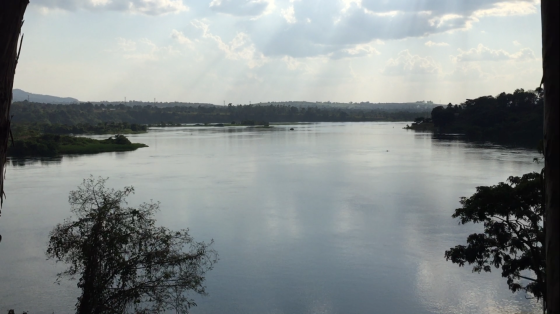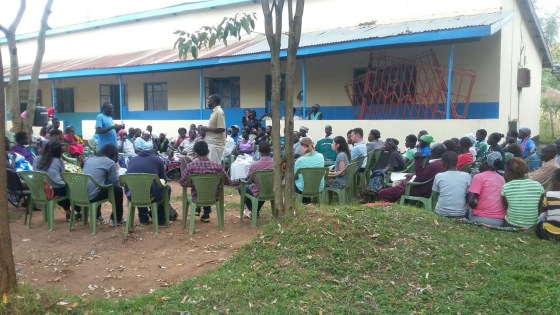For our last day in Jinja, we had some free time and decided to take advantage of the tourist attractions and activities .The girls left early in the morning to go white water rafting, while the boys finished up a couple of remaining interviews then went kayaking in the Nile.
White water rafting down the Nile was great! During one of the rapids, the raft tipped so much that Rachel let go of the rope, flew across the raft, and tackled Polly into the water. There were many points along the river where we were able to jump out of the raft and just float along with the current. At one point, the guide yelled at us to jump off while we were in the rapids, which was slightly terrifying. The ride back from the river to the hotel was an added bonus, as we were able to stand on the back of an open truck and we sped along the countryside. When we got back to the hotel, we asked the staff for a clean towel, which somehow turned into an hour long photoshoot with the entire hotel staff. We’re still confused as to how or why this happened, but it was a fun experience.
The boys finished up interviews with a pediatrician and LC5 in the morning, then went down to the Nile River to partake in river activities (aka kayaking). Andrew and Mohit parked their kayak on a rock in the middle of the river, and Mohit made the mistake of letting Andrew man the kayak. The kayak ended up floating away, and they were stranded on the rock, shouting for help, as Matt just watched from the shore. A passing motorboat attempted to push their kayak back to the rock but failed, so a fisherman named Adam XXX (we’re not really sure about the XXX part either) gave Andrew and Mohit a ride to their kayak. On the short boatride to the kayak, he tried selling them flowers. Again, we’re still confused as to how or why this happened. The girls took a boda boda to the Black Lantern to meet up with the boys, where we all caught up with stories from our day and ate more banana crepes.
The next morning, we said goodbye to the staff at the hotel and left Jinja for Kampala. With Polly’s expert(?) navigation, we were able to find the airbnb home that we were renting for our stay in Kampala. The girls met up with Winnie at the African Village Craft Market, where they bought gifts for people back at home. Matt and Andrew went to a casino with the very few remaining shillings they had. Mohit, having learned that there was wifi in our rented home, decided to stay back and enjoy some time away from us.
![IMG_1012[1]](https://cbidneonatalteam1617.files.wordpress.com/2016/08/img_10121.jpg?w=560)
For dinner, we had planned to go to a restaurant called Carnivore, which is similar to a Brazilian steakhouse except with exotic meats such as crocodile, ox balls, and buffalo. We heard about Carnivore even before the trip and didn’t have time to go to the one in Kenya, so we were pretty excited to finally go in Uganda. However, miscommunication led us to a similar type of restaurant called Carnival. Although we were disappointed and convinced that the food at Carnivore was better, it was still an experience being able to try antelope, buffalo, and crocodile meat.
On Sunday, we went to Cafe Javas for lunch, where we were finally able to satisfy our craving for “American food”. As much as we enjoyed trying the local foods in Kenya and Uganda, we still missed the comfort foods of home. We met with Dr. Waiswa and updated him on all the insights we gathered during our week in Uganda. We had wanted to go to the RAN lab at Makerere University before we left for the States, but sadly schedules didn’t end up working out.
We stopped by the supermarket on the way back to the apartment to buy dinner, which ended up being old instant ramen that was on clearance because we were running low on money. The wifi in our apartment was limited to 1.5GB, so we had to ration our internet usage. It was stressful trying to count megabytes and prioritizing what was important enough to use our internet for, but it definitely made us appreciative of the unlimited internet back at home. We spent the rest of the night discussing insights from our time on the field, closing up our global trip, and planning the next few weeks when we get back to the States.
We will be flying out tomorrow to head back to Baltimore. We’re sad to leave, and we’ve definitely learned a lot during our past few weeks, but we’re also excited to head back to start translating our observations into design considerations for our device 🙂

![IMG_5637[1] IMG_5637[1]](https://cbidneonatalteam1617.files.wordpress.com/2016/08/img_56371.jpg?w=370&resize=370%2C247&h=247#038;h=247)

![IMG_5756[1] IMG_5756[1]](https://cbidneonatalteam1617.files.wordpress.com/2016/08/img_57561.jpg?w=182&resize=182%2C121&h=121#038;h=121)



![IMG_1012[1]](https://cbidneonatalteam1617.files.wordpress.com/2016/08/img_10121.jpg?w=560)























































